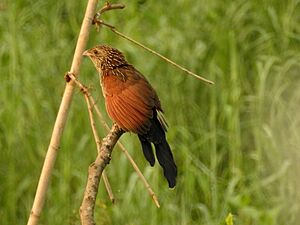Lesser coucal facts for kids
Quick facts for kids Lesser coucal |
|
|---|---|
 |
|
| Conservation status | |
| Scientific classification | |
| Genus: |
Centropus
|
| Species: |
bengalensis
|
| Subspecies | |
|
See text |
|
The lesser coucal (Centropus bengalensis) is a type of cuckoo bird. It belongs to the family Cuculidae. This bird lives in many places, and its home often includes marshy areas with lots of grass and trees.
You can tell the lesser coucal apart from other similar birds because it is smaller. It also has a less noticeable beak and pale streaks on the feathers of its head and back. One special feature is its very long claw on its back toe. It also has a unique call. Unlike many birds, male and female lesser coucals look very similar. However, they are one of the few coucals that change their feathers slightly with the seasons.
Contents
About the Lesser Coucal's Name
The lesser coucal was officially described in 1788 by a German scientist named Johann Friedrich Gmelin. He included it in his updated book, Systema Naturae. Gmelin first put this bird in the genus Cuculus and gave it the scientific name Cuculus bengalensis.
He based his description on a bird from Bengal that an English scientist, Peter Brown, had described earlier. Today, the lesser coucal is part of the Centropus genus. This name was created in 1811 by a German zoologist, Johann Karl Wilhelm Illiger. The name Centropus comes from ancient Greek words meaning "spur" or "spike" and "foot." This refers to their long hind claw.
Lesser Coucal Subspecies
Scientists recognize six different types, or subspecies, of the lesser coucal:
- C. b. bengalensis: Found in India, Nepal, Myanmar, Thailand, and Indochina.
- C. b. lignator: Lives in southern and southeastern China, Hainan, and Taiwan.
- C. b. javanensis: Found from the Malay Peninsula to Sumatra, Java, Borneo, and parts of the Philippines.
- C. b. philippinensis: Lives in most of the Philippines. Sometimes, scientists group this one with javanensis.
- C. b. sarasinorum: Found on Sulawesi, Sangihe, Talaud Islands, and the Lesser Sunda Islands.
- C. b. medius: Lives in the Moluccas (except Kai Islands).
Scientists have studied the DNA of lesser coucals. They found that this bird is more closely related to the black coucal and Philippine coucal.
What the Lesser Coucal Looks Like
This coucal is a bit smaller than some other coucals. It has a shorter beak. Its most notable feature is its very long claw on its back toe, which is the longest among all coucals.
Most of the lesser coucal's body is blackish. It has a long tail and reddish-brown wings. They have two main feather patterns:
- Breeding plumage: During breeding season, their head and upper back look shiny. The feather shafts are dark.
- Non-breeding plumage: When not breeding, their feathers are duller. The feather shafts on their head and back are whitish. Their wing feathers also have pale shafts, making them look like whitish streaks.
The lesser coucal's eyes are a darker brown. This is different from the greater coucal, which has crimson red eyes. Young lesser coucals have black spots and bars, and they are browner in color.
Lesser Coucal Calls
The calls of the lesser coucal sound like a series of low, double "whoot-woot" or "kurook" notes. These calls get faster and lower in pitch as they go on. The Indonesian name for this bird, dudut, sounds like its call.
Where Lesser Coucals Live
Lesser coucals are found across a wide area. This includes the Indian subcontinent (but not Sri Lanka) and extends east across Southeast Asia. There are slight differences in their size and feathers depending on where they live.
Lesser Coucal Behavior and Life
Lesser coucals are usually seen alone or in pairs. They stay low in the plants, often in marshy or grassy areas next to forests. They seem to prefer living in lowlands.
Unlike some other cuckoos, lesser coucals do not lay their eggs in other birds' nests. They build their own nests. They usually nest from May to September, especially after the rains in June in India. Their nest is shaped like a dome and is made of grass blades. They build it on a low tree.
A female lesser coucal typically lays 3 eggs in India, 2 in Southeast Asia, and 4 in Taiwan. Both the male and female coucals take turns sitting on the eggs to keep them warm. They also both help care for the young birds once they hatch.


